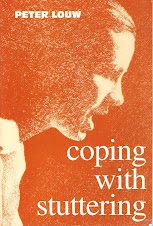You will note that, in this blog, some lesser known terms are used when discussing stuttering - words such as stuttering threshold, base-level tension, laryngospasm, speech tension, word or sound stress, speed stress and others. These terms all have defined meanings that will become clear as I further develop the blog. In particular the meanings will be found in my free online book Coping with Stuttering (which you can read by clicking HERE - you can also use that blog's search engine to find the meanings of these terms). These terms are vintage Schwartz concepts with which he has immensely enriched our insight in stuttering.
Some time after doing Schwartz's intensive course I began to expand my knowledge of stuttering, and gradually I noticed that Schwartz's ideas - which so corresponded with my own experiences of stuttering and seemed so clear and logical - differed somewhat from what is generally accepted by most speech clinicians. This coincided, perhaps not surprisingly, with an apparent backlash from some conservative speech clinicians.
Schwartz was heavily criticised for, amongst others, his first book with the challenging title Stuttering Solved (1976). Highly controversial, the book was translated in five languages. Though Schwartz later admitted that some of the statements in that book were naive, much of the criticism against the title resulted from a perhaps deliberate misreading. The phrase 'stuttering solved' has a double meaning; it can mean that the problem of stuttering has been solved, or it can mean that the cause of stuttering has been found. Schwartz has always insisted that he has indeed identified the cause of stuttering and he has never wavered from this view. This firm conviction may at the time have led him to believe that effective management of all stuttering had also arrived. This was indeed rather simplistic; but it does not detract from his other findings and techniques which are of huge importance to all people who stutter.
Based on the idea that stuttering can be prevented by slightly opening the vocal cords before speaking, he developed the Passive Airflow Technique, which is today used by various individual therapists and stuttering institutes. Like all fluency techniques it is not a miracle cure, needs to be learned from a qualified professional and practised a great deal so that it becomes a habit.
Subscribe to:
Post Comments (Atom)






You are right Peter! I also went to speech clinic for 2 months they often try to eliminate stuttering by diaphragmatic breathing method which i believe reduces stress, i found it helping but not expected results. It seems that their is no one in Pakistan who uses the Airflow technique! that's why i usually depends on books.
ReplyDelete